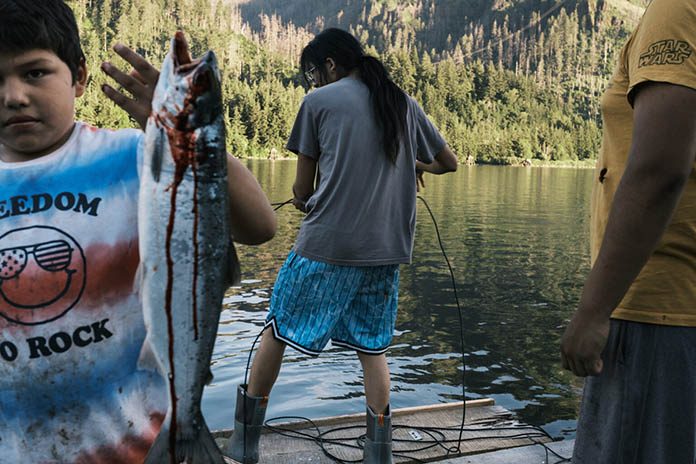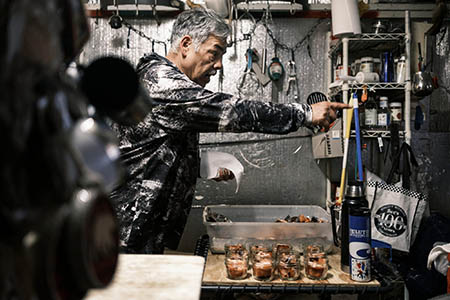
By Jordan Gale and Alex Baumhardt/Oregon Capital Chronicle
This summer for the first time the U.S. government acknowledged that nearly a century of damming waterways in the Columbia and Snake rivers for hydroelectricity has devastated fish runs central to the lives of Northwest tribes.
Its report, released in June, made headlines and followed promises by the Biden administration to restore native fish populations to the rivers.
But tribal members who fish and live along the Columbia River remain skeptical.
“I don’t think much will ever change on the river,” said Ralph Whitefoot, a fisherman on the Columbia River and a member of the Yakama Nation. “I’m sure as hell not going to get my hopes up.”
Another Columbia River fisherman, Rebecca Winnier, a member of the Yakama Nation, said the report rang hollow because the authors didn’t pledge to take the dams out.
“We need to let these dams go,” Winnier said. “We’re just out of balance.”
Winnier, who just celebrated her 46th birthday, is a member of the Yakama Nation. Apart from a six-month stint in central Washington’s Tri-Cities area, she has spent her entire life in and around the town of White Salmon, on the Columbia River. She’s built up a large fishing company called Northwest Fish Hogs. Her operation is large, but she still uses a traditional hoop method of catching fish that tribes in the region have used for thousands of years. She points up the river to where her uncles, aunts and her father used to fish – within eyesight of where she fishes now.
“Salmon are a part of our creation story. It would be very difficult to separate fishing and this river from our identity,” she said.
In 1855, the Nez Perce, Umatilla, Warm Springs and Yakama tribes entered into a treaty with the federal government, ceding millions of acres of their land to the U.S. In return, the federal government guaranteed their hunting and fishing rights at traditional sites in perpetuity.

Between 1938 and 1975, the U.S. Army Corps of Engineers built 11 hydroelectric dams on the Columbia and Snake rivers. Bonneville Dam was the first to go up, and it’s the last one before the Columbia River meets the Pacific Ocean.
The dams deprived the region’s tribes of their traditional fishing areas by blocking salmon runs and isolating tribal members from the food they’ve depended on for milenia. The dams also flooded tribal fishing villages and structures when reservoirs were created, burying thousands of acres of tribal land and sacred sites underwater.
After the dams were built, tribal members found themselves limited to fishing – and sometimes living – in unfamiliar areas on both sides of the river that were designated by the U.S. government for the four Columbia River Treaty tribes. Some sites don’t have potable water or even electricity even though the power-producing Bonneville Dam is just miles away.
“I’d really like to see some resources in place for those that are left out here,” said Connie Shippentower, a member of the Confederated Tribes of the Umatilla Indian Reservation who fishes along the Columbia River.
Shippentower has spent a large portion of her life along the lower section of the Columbia River. She and her ex-husband began building a fishing complex in 1988 while she was pregnant with her youngest of two sons. They chose a spot near a former tribal village that was flooded during dam construction.
Although she now lives on the Umatilla Reservation near Pendleton, Connie regularly treks down Interstate 84 to help family and friends with fish canning and other odd tasks.
Whitefoot also knows the Columbia River well. He’s 63 and raised his three daughters at a U.S. designated site east of Stevenson, Washington.

Whitefoot has fished in the Columbia River his entire life. He catches a variety of fish but mainly salmon. He also smokes and cans his fish and those caught by other tribal members. He sells the products at farmers markets and tribal events as far away as Seattle and caters ceremonies and weddings.
Everyone who gathers at tribal fishing sites along the Columbia River depends on the salmon, even if they don’t fish themselves. Some focus on cleaning boats and making and selling nets while others prepare the fish to go to markets.
Whitefoot is among those who do it all – and he intends to remain along the river.
“For me, when the net is out, and I’m picking blackberries from the bushes, it’s a good life,” Whitefoot said. “It ain’t much, but it’s mine.”
Whitefoot often works with Farley Eaglespeaker, a member of the Nez Perce Tribe. Eaglespeaker was born and raised in Lewiston, Idaho along the Snake River and, at 21, is the owner of Eagleboys Fish, which sells whole fish and packaged fish from the Columbia River.
He still spends most of the time in the Lewiston area, but when he’s not playing in basketball tournaments, he and three friends drive down Interstate 5, catching and selling fish as far as Vancouver, Washington and Portland.
Eaglespeaker said he thinks a lot about the complexity of traditional relationships with the fish in the Columbia and Snake Rivers and fishing for profit in a river system that was once just a part of their culture, not a business.
“We’re not supposed to fish for the money, but we have to because it’s the world we’re born into now,” he said.
This story first appeared in the Oregon Capital Chronicle.










